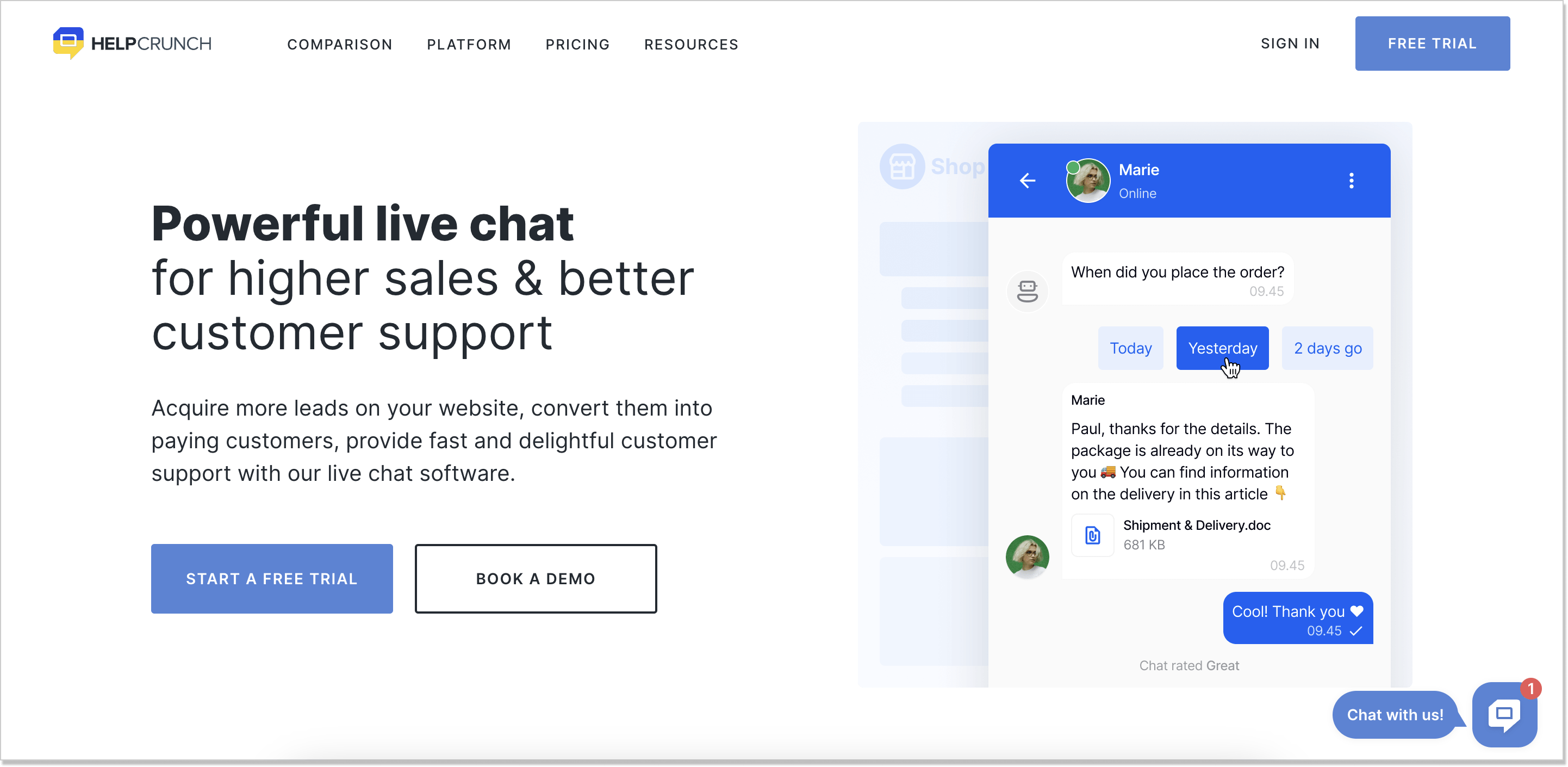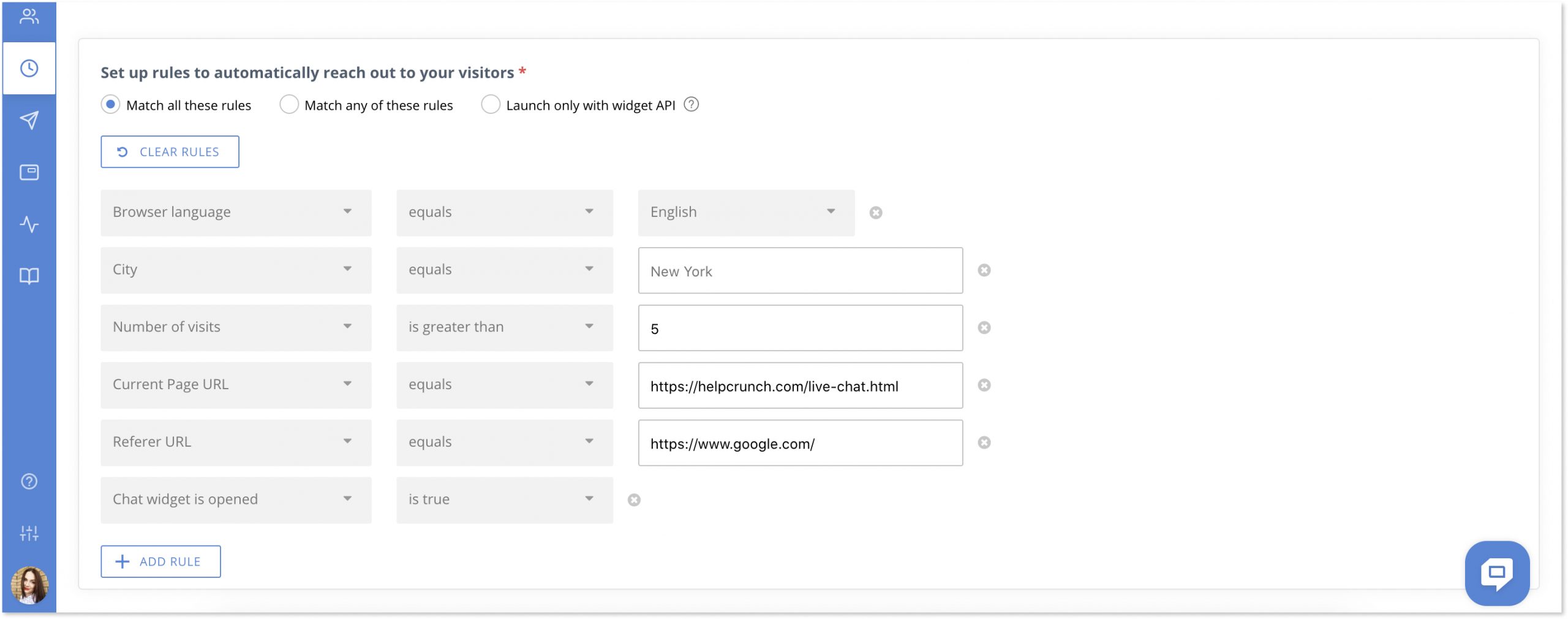Proactive Chat 101: Definition, Best Practices, Useful Examples
Don't just wind down and wait for your customers to come to you first. Use a proactive chat feature for better customer experience and engagement instead.
Written by Olesia Melnichenko

When you want to lend a helping hand to a website visitor, you can do it in two different ways. If you go with the first one, you can sit tight and answer customers’ complaints and questions when they ask you to. This is a reactive approach.
But if you opt for the second option, you can show your initiative before a customer asks for it. This is how proactive live chat works.
You can choose whatever approach you want, but it’s a lot more effective to reach out to a client first and show that you can handle a potential issue. As a result, a customer gets a detailed response and feels valued. So, how can proactive chat be described and how can it grow your business? Read on to find out all the answers.
What is proactive chat?
Proactive chat messages are fully automated messages that invite your site visitor to start a conversation. Such a feature helps a live chat agent take the initiative, show concern, and willingness to solve customers’ issues as soon as possible.

Comparable to a brick-and-mortar store’s salesperson, a customer support expert invites a visitor to talk. It’s now easier to make the first step with proactive chat software than it was years ago. Do you want to see some of the proactive chat best practices to use it in your business? This is our next stop here.
Proactive chat best practices
There are certain tactics that will allow you to really engage customers instead of irritating them. Let’s now focus on proactive live chat do’s and don’ts, what you should and should not do to make proactive messages work wonders:
1. Know your timing: for starters, set a message trigger up to 1 minute. All in all, you don’t want to charge at visitors all at once, give them some time to look around. But how do you know which moment is right? For that, you can check the average time spent on a page with Google Analytics or any other similar tool, identify when a customer is familiar with the content but is about to leave. After that, send a proactive chat message offering your help.
For instance, you see that a client makes final touches on the order for one minute. Trigger a proactive message at 50 seconds, saying ‘Hey! Do you need any assistance with your order? I’ll be happy to answer any questions.’
2. Make your proactive chat personalized: with this type of chat, there’s no point in hiding behind a mask. Show your customers who you are, introduce yourself, and shape a conversation in a friendly way. Try to avoid generic Yes/No questions and ensure that your conversations are meaningful. You can also shape your message according to a client’s current country, city, or browser language using special chat triggers for that.
3. Keep conversations specific and relevant: use two different approaches when a person browses a pricing page or a technical support page. For example, starting the sales pitch if a client faces some technical issue is not the best-case scenario. A customer waits for a solution, not another deal. As your goal is delivering service, prioritize clients’ needs. Identify their preferences, and send a proactive message with some options inside.
For instance, instead of generic ‘Need help?’ go with ‘Hey! Need help choosing a great pair of running shoes?’.
4. Be proactive but know your limits: let your customers close a chat window or ignore a conversation when they want it. Make sure your help is appropriate and you don’t irritate a client. For instance, a message ‘Hey, you’ve added an item to your shopping cart. Proceed to the payment section.’ may seem too imposing. Besides, don’t put a flashy live chat window on every site’s page. Choose a few ‘strategic’ pages instead and make the most of them there.
5. Specify the number of proactive messages: there are triggers that allow you to monitor the number of proactive chat invitations you have already sent. Set them up if you don’t want to bombard customers with bulks of messages on every page. These rules are ‘Number of sent proactive invitations’ and ‘Time since the last proactive invitation’.
Proactive chat use cases and examples
You should always remember that abusing proactive chats isn’t helping. However, there are a few proactive chat examples and use cases when a well-thought-out and nonintrusive message can hit the nail on the head.
1. Reduce cart abandonment
Cart abandonment is a pain in the neck for eCommerce today. 76% of consumers don’t finalize their purchase and click away. This often happens due to a lack of knowledge (about shipping costs, checkout procedure, etc.) and timely customer support reps help.
A live chat agent can change the situation for the better by sending a proactive message offering assistance knowing an average time a client spent on a page. This way, a customer will interact with a customer care rep, tell what the problem is, and complete a purchase.
2. Greet returning visitors
If you offer warm and high-quality service, customers will come to you for more. And if you notice a recurring visitor who has visited your website before, make sure you have all the valuable data about them. To check it, set up your proactive live chat software using such triggers as visit times, chat times, time on a website, time on a page, or order history. By sending a visitor a ‘welcome back’ message, ask how much they enjoyed their last purchase, and offer a helping hand.
3. Upsell and cross-sell
Proactive live chat doesn’t just make for more conversations and goes beyond just cart abandonment reduction. By chatting with customers proactively, you can increase basket value through upselling and cross-selling techniques. A set of helpful metrics you can make avail of may vary: current page URL, shopping cart item, and time on the current page.
Once a client adds an item to a cart, reach out to them by offering complementary products, or make sure the customer is informed about your current deals. This trick encourages a client to purchase more stuff from you whilst the buying mood isn’t over yet. And a live chat agent can reinforce product recommendations if need be.
4. Engage visitors from various geographical locations
Identifying which customers are of great value is important. If your customer statistics suggest that clients from a specific area have the most intent to buy, they’re an ideal target for a proactive chat invitation. Useful metrics here are country/region, city, current page URL, time on website, and time on the current page.
5. Track pages with high exit/bounce rate
Use Google Analytics to detect your high bounce rates pages. To prevent visitors from clicking away, you can send a message based on time spent on the current page or exit intent.
With a rule-based proactive chat, you can set up an invitation for a conversation to automatically show up when a visitor is on a page for at least 10-15 secs.
You can also utilize a proactive rule that HelpCrunch has which is ‘Time before exit intent’. It allows specifying the time that a user should spend on a page before leaving it (exit intent). At this point, they get a message (for instance, offering a discount).
6. Monitor product pages
If a customer lingers around a specific product page, it means that there are some doubts or questions. Trigger a proactive message with ‘Time on page’ rule after 30 secs asking if there’s anything you can help with. This will help close a deal faster.
7. Keep an eye on referral pages
By tracking referring URLs, you can build a great conversation. For instance, if a visitor comes from a landing page where you promote your products or services, ask in a proactive chat invitation if there are questions about that promo. The metrics needed here are referral page URL, current page URL, and time on page.
Now that you’re well-versed in both pros and cons of proactive live chat and have looked through some examples, you might want to embed it into your website. Check out a simple step-by-step guide for that below.
How to set up proactive chat messages on your website
Install the HelpCrunch proactive chat to see how it works with your website. Once you’re done, you’ll get a nice chat live chat button at the bottom of your website, where people can communicate with you in real time.
Time to tweak proactive chat messages.
1. In the ‘Auto messages’ section, you can select a widget or an app your message will be enabled for, decide when to show it and whom to send it to or set it up using certain rules.
2. You can pick various proactive chat rules like browser language, time on page, chat history with a visitor, to name just a few. So, whenever someone matches the criteria, they’ll see a personalized chat message offering help.
3. Write a compelling personalized proactive chat message.

Final Thoughts
As you can see, there are dozens of reasons that make proactive chat a must-have feature. It helps provide instant assistance, keep track of users’ behavior, make them satisfied, and many more. Besides, it’s a perfect tool for taking the lead and engaging visitors.
If you implement a proactive live chat strategy properly, the chances are that the number of sales and leads will increase. But if something goes wrong, customers can bounce off your website.
Are you ready to put proactive chat into action? Then take a free 14-day test run with HelpCrunch and offer your customers proactive help using all-in-one software.





